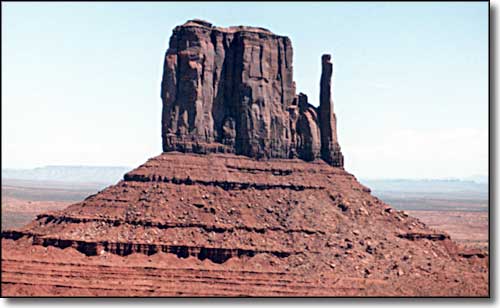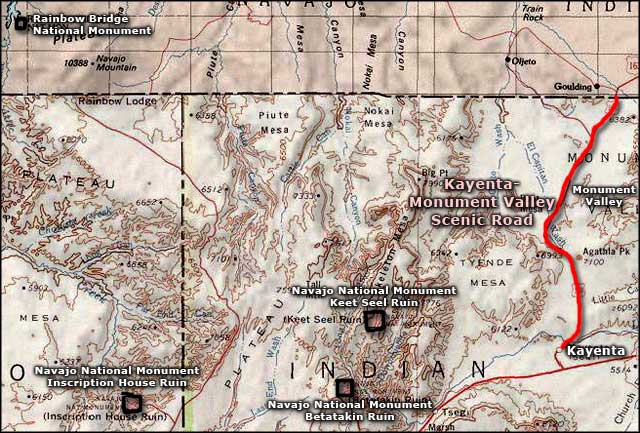
Kayenta-Monument Valley Scenic Road

One of the famous Mittens in Monument Valley
The Kayenta-Monument Valley Scenic Road runs along US Highway 163 from Kayenta to the Utah border, almost 28 miles. This is a drive on a paved road through those beautiful red sandstone pillars, walls, spires, hoodoos and other monoliths into the famous Monument Valley on the Navajo Nation. This is countryside made famous by movie producer John Ford. This countryside, in turn, helped make John Wayne famous for all the "work" he did in this area.
Kayenta is a Navajo settlement that was probably settled after the Navajo returned from "The Long Walk" in 1868. John and Louisa Wetherill were the first Anglos to settle in the area, opening a trading post south of Kayenta in 1906. In 1910, they moved the trading post into Kayenta. In 1927, an archaeological expedition funded by the American Museum of Natural History and led by Charles L. Bernheimer arrived in the area. John Wetherill guided them around the area and found people who could take them to places like Rainbow Bridge and the Clara Bernheimer Natural Bridge (even more remote on the Navajo Nation than Rainbow Bridge).
It was Harry Goulding, another trading post operator out of Oljeto, who made the trip to Hollywood during the Great Depression and showed the photos to producer John Ford that brought Ford and his film crews to Monument Valley for movie after movie after movie. In the early days, the movies were about the hard life of the homesteaders, the dangers of the outlaws and the Indians, and how the military would arrive and save all the Anglos by killing all the Indians. At one point, Ford said: "I've killed more Indians than Custer, Beecher and Chivington put together." In the 1960's, Ford's subject matter changed a bit (to the trials and tribulations of a black Buffalo soldier (Sergeant Rutledge, 1960) and the journey of 300 Cheyenne who refused to live on a reservation and ran to get back home (Cheyenne Autumn, 1963)), but he still enjoyed filming in Monument Valley.
This route travels through the Arizona section of Monument Valley to the Utah State line. If you'd like to get closer to the monuments themselves or just get further out in this fantastical red rock countryside, you'll probably have to hire one of the guides available at the Monument Valley Visitor Center as the area off the road is now part of a Navajo Tribal Park.

More monuments

Kayenta-Monument Valley Scenic Road area map
